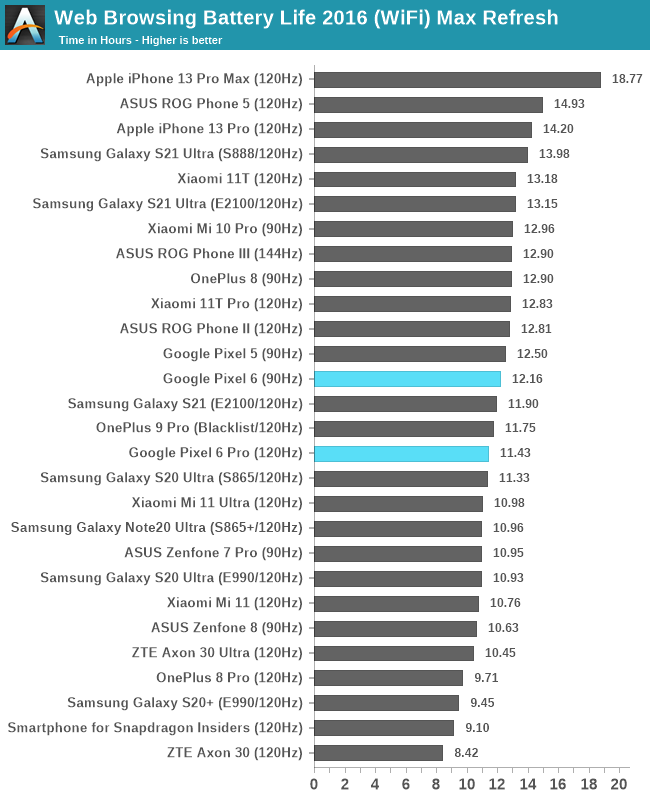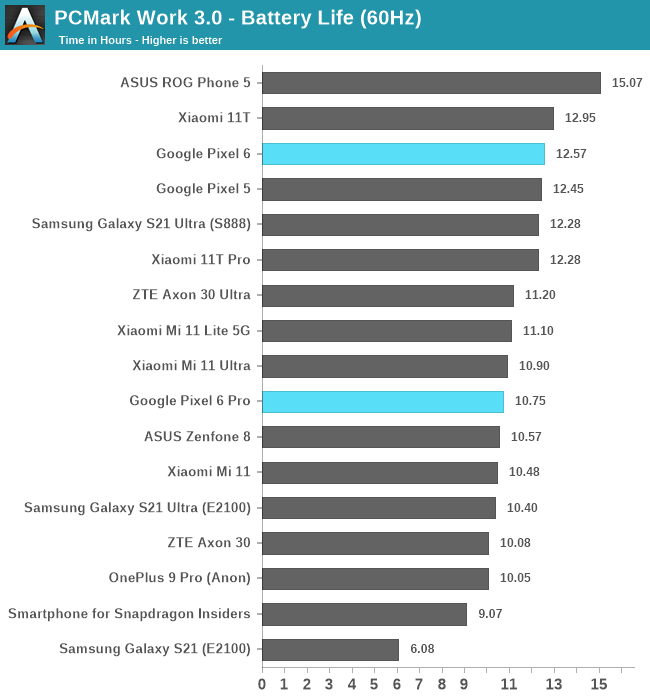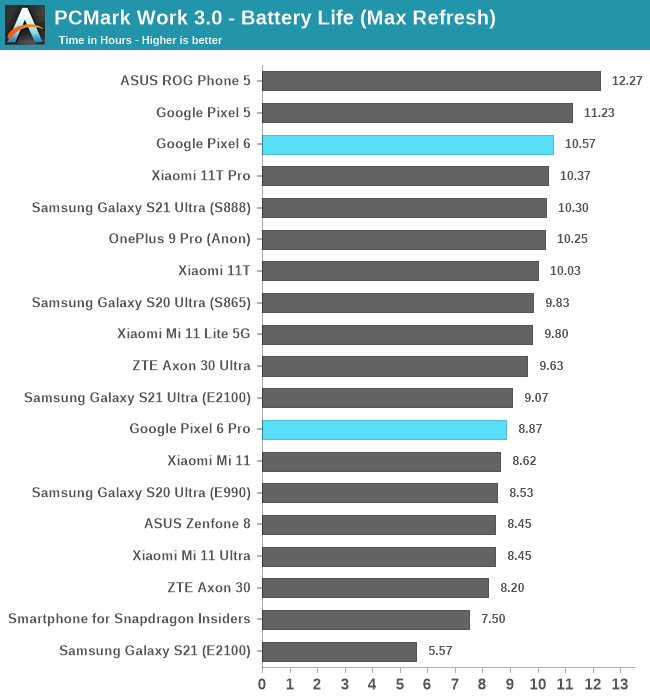Google's Tensor inside of Pixel 6, Pixel 6 Pro: A Look into Performance & Efficiency
by Andrei Frumusanu on November 2, 2021 8:00 AM EST- Posted in
- Mobile
- Smartphones
- SoCs
- Pixel 6
- Pixel 6 Pro
- Google Tensor
Phone Efficiency & Battery Life
While not directly released to the Google Tensor, I also finished running the various battery tests for the Pixel 6 and Pixel 6 Pro, and there are some remarks to be made in regards to the power efficiency of the devices, and how the new SoC ends up in relation to the competition.
As a reminder, the Pixel 6 comes with a 4614mAh battery and a 6.4” 1080p 90Hz OLED screen, while the Pixel 6 Pro features a 5003mAh battery and a 6.71” 1440p 120Hz OLED display, with variable refresh rate from 10-120Hz.

Starting off with the 60Hz web browsing results, both Pixel phones end up extremely similar in their longevity, at 14 hours runtime. The regular Pixel 6 is hard to compare things to as we don’t have too many recent phones with 90Hz displays in our results set, however the Pixel 6 Pro should be a direct comparison point to the S21 Ultras, as both feature 5000mAh batteries and similar display characteristics. The P6Pro here ends up slightly ahead of the Exynos 2100 S21 Ultra, which might not be too surprising given that the Tensor chip does end up at somewhat lower CPU power levels, even if performance is lower. It’s still quite behind the Snapdragon 888 variant of the S21 Ultra – which is again quite representative of the SoC efficiency differences.

Running the phones at their respective max refresh rates, both devices see larger drops, however the Pixel 6 Pro especially sees a more substantial hit. This time around, the 6 Pro ends up significantly behind the Exynos 2100 S21 Ultra, which had only a minor drop in the 60 -> 120Hz results.

Shifting over to PCMark at 60Hz, we see that there’s a larger difference in favour of the Pixel 6, as the Pixel 6 Pro ends up behind it in longevity by almost two hours. The 6 Pro still ends up in line with the E2100 S21U, however that device showcases significantly higher performance numbers in the test, which acts both as a performance metric for device responsivity as well as a battery life test.

At 120Hz, the 6 Pro ends up worse than the E2100 S21U, and quite worse than the S888 S21U.
When I was investigating the phones, the 6 Pro’s power behaviour was quite weird to me, as I saw best-case baseline power figures of around 640mW, and sometimes this inexplicably would also end up at 774mW or even higher. What this reminded me of, was the power behaviour of the OnePlus 9 Pro, which also suffered from extremely high baseline power figures. Both the 6 Pro and the 9 Pro advertise themselves as having LPTO OLED panels, but both of them very clearly do not behave the same as what we’ve seen on the Note20Ultra or the S21Ultra phones. The 6 Pro also only goes up to up to 750 nits 100% APL peak brightness in auto-brightness mode under bright ambient light, which is significantly lower than the S21U’s 942 nits. I think what’s happening here is that the Pixel 6 Pro simply doesn’t have the most state-of-the-art display, and thus is quite less efficient as what we find on the competition. It does kind of make sense for the price-point of the phone, but also explains some of the battery behaviour.
Naturally, the Tensor SoC also just doesn’t appear to be as efficient. Particularly many UI workloads would be run on the A76 cores of the chip, which just outright have a 30% perf/W disadvantage. The phone ends up OK in terms of absolute battery life, however performance metrics are lower than other devices.
I think the regular Pixel 6 here is just a much better device as it doesn’t seem to have any particular issues in display efficiency, even if it’s just a 1080 90Hz panel. There are naturally experience compromises, but it’s also a $599 phone, so the value here is very good.
US readers who are used to Qualcomm phones might also encounter efficiency regressions when under cellular data – we abandoned doing testing here many years ago due to the impossible task to get consistent test environments.










108 Comments
View All Comments
melgross - Wednesday, November 3, 2021 - link
Apple couldn’t integrate Qualcomm’s modems in their own chips because Qualcomm doesn’t allow that. They only allow the integration of their modems into their own SoC. It’s one reason why Apple wasn’t happy with them, other than the overcharging Qualcomm has been doing to Apple, and everyone else, by forcing the licensing of IP they didn’t use.ChrisGX - Thursday, November 4, 2021 - link
Yes, but all that conjecture hasn't been confirmed by any reputable source. And, the statements by Phil Carmack and Monika Gupta indicate Google has been optimising for power (most of all) and performance (to a lesser degree) rather than area. We end up back at the same place, using the A76 cores just doesn't make a lot of sense.Also, the A78 is perhaps 30% larger than the A76 (on a common silicon process) whereas, I think the X1 is about twice the size of the A76. I'm not sure what the implications of all that is for wafer economics but I'm pretty sure the reason that Tensor will probably end up suffering some die bloat (compared to upper echelon ARM SoCs from past years) despite the dense 5nm silicon process is the design decision to use two of those large X1 cores (a decision that Andrei seems perplexed by).
Raqia - Tuesday, November 2, 2021 - link
The Google TPU only trades blows with the Qualcomm Hexagon 780 with the exception Mobile BERT. It's not an especially impressive first showing given that this is Google's centerpiece, and it's also unclear what the energy efficiency of this processor is relative to the competition. It's good there's competition though; at the phone level, software is somewhat differentiated and pricing is competitive.webdoctors - Tuesday, November 2, 2021 - link
Even if the performance isn't impressive, the big deal is guaranteed SW updates. Look at the Nvidia Shield, it came out in 2015 and its still getting the latest Android updates/OS! No other product has been updated for so long, 6 YEARS!Now that Google owns the SoC they have full access to the SoC driver source code so should be able to support the SoC forever, or at least ~10 years....not reliant on Qualcomm's 3 yr support term etc.
BlueScreenJunky - Tuesday, November 2, 2021 - link
Yeah, except they only guarantee 3 years of software update and 5 years of security updates, which is really a shame if you ask me.If they could have guaranteed 5 years of OS updates from the start it would have been a very strong selling point. Especially since the difference between each generation becomes smaller every year, I could see people keeping a Pixel 6 for well over 3 years... How cool would that be to keep a $599 for 5 years and still run the latest android version ?
webdoctors - Tuesday, November 2, 2021 - link
I agree: https://support.google.com/pixelphone/answer/44577...They should've just guaranteed 5 years for SW updates. Based off the pixel 3 being guaranteed for 3 yrs and than this month dropping security updates for Pixel 3 from their list, they're serious about guaranteeing being the maximum support they'll provide which is unfortunate. Maybe they'll update it this year cause that seems like a big hole.
TheinsanegamerN - Tuesday, November 2, 2021 - link
Why? What new features do you NEED in your phone? Android stopped evolving with 9, iOS with about version 11. The newest OSes dont do anything spectacular the old ones didnt do.You're getting 5 years of security updates and dont have apps tied to OS version like apple, giving the pixel a much longer service life then any other phone.
tipoo - Tuesday, November 2, 2021 - link
They're saying 3 years of OS updates, a far shot from 10. 5 years of security updates, which is a start, but owning their supposed own SoC they should have shot for 5 of OS.BillBear - Wednesday, November 3, 2021 - link
After all the build up on "We're going to have our own chips now so we can support them without interference from Qualcomm", three years of updates is seriously underwhelming.Apple has six year old phones running the current OS and the eight year old iPhone 5s got another security update a month ago.
Google needs to seriously step up their game.
melgross - Friday, November 5, 2021 - link
All we know now about software updates is that it will get five years of SECURITY updates, nothing about OS updates was stated, as far as I see. If that’s true, they Google may still just offer three years. Even now, Qualcomm allows for four years of OS updates, but not even Google has taken advantage of it. So nothing may change there.